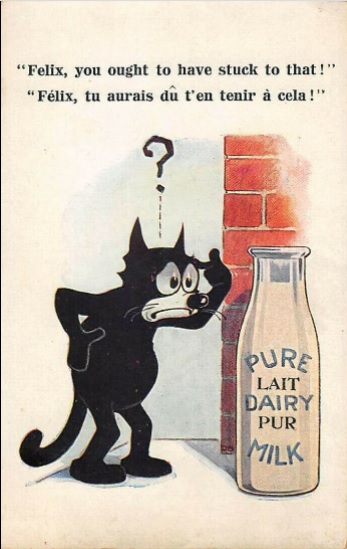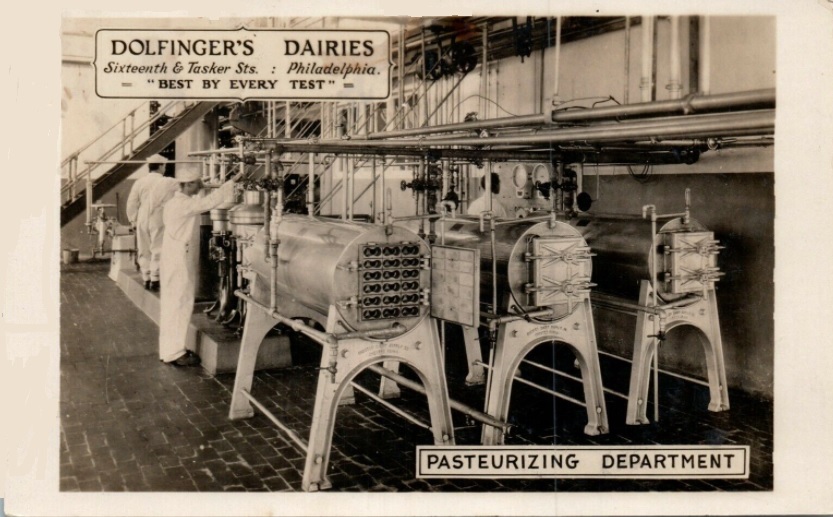George Miller
The Crusade for “Pure” Milk
We’ve learned to be suspicious of many of the foods we eat today. It’s not just that they may contain dangerous additives, be high in saturated fat, or have calories “empty” of nutrition. It’s that the foods might actually poison us. We’re told never to eat raw eggs, to wash our cantaloupes before cutting them, and to be careful of how we cook chicken. Given the hazards we seem to face in our own clean kitchens, I often wonder what it must have been like at the turn of the twentieth century when surely food preparation and refrigeration were not as they are today.
On the other hand, there are some foods that most people have no fears about — milk is a good example. As long as the milk is fresh and has been kept cold, people don’t think twice about drinking it. At the turn of the century, however, it was much different.
Contaminated milk posed a serious threat to people during the golden age of the postcard, and contaminated milk could be found everywhere.

A “vinegar” postcard valentine in a long series signed by Myer.
TO THE MILKMAN
‘‘Purest milk you claim to sell;
All the neighbors know full well
That it’s water, and they say
You are pumping every day.”
Raw Milk
Raw milk was dangerous then because it was, as the books say, “the only animal food taken in its raw state.” In the days before pasteurization, the milk you drank was direct from the cow, unprocessed in any way. The result was that milk, particularly the milk available in cities, was very frequently contaminated with bacteria. As one 1917 study noted:
“Milk in its pure state is a most desirable food; but conditions today make it almost impossible for a person of average means to obtain such milk. Congestion in population, which prevents cows being pastured nearby, makes the cities dependent upon milk that is often two to three days old. The high cost and the difficulty of securing care and fidelity exclude the possibility of cleanliness in stable and dairy. The impossibility of efficient supervision of the health and cleanliness of the dairy hands and of the herd causes the constant peril of disease germs in the milk. All these conditions tend to make milk as it comes from the farm today an unsafe food. Under present conditions milk as it is brought to the market and to the consumer is full of bacteria more or less dangerous to life.”
Milk as a Carrier of Disease
The studies linking raw milk and disease were many, and their conclusions were consistent. Among the diseases most clearly linked to contaminated milk were typhoid fever, diphtheria, scarlet fever, infectious sore throat, tuberculosis, and a host of intestinal disorders. A publication of the Hygienic Laboratory of Washington, D.C., traced outbreaks of typhoid, scarlet fever, and diphtheria to infected milk. Comparisons required by law of disease rates before and after pasteurization showed the link quite clearly. In Philadelphia, for example, there were 2,872 cases of scarlet fever in 1912 and 3,400 in 1913. In 1914, after the pasteurization of milk was mandated, the incidence sharply declined in 1914 and in 1915.
Bovine tuberculosis was quite prevalent in dairy cattle in the United States, though it was commonly thought that bacilli in cattle were no threat to human beings. Scientific studies eventually showed, however, that while bovine tuberculosis was not responsible for ordinary pulmonary consumption in adults, it was a factor in tuberculosis in children—as many as 10% of the tuberculosis deaths in children were traceable to contaminated milk.
Not only was the milk supply of large cities often dependent upon cows housed in the filthiest of conditions, but the milk was typically 36 to 48 hours old before it was sold and, of course, it was typically unrefrigerated for that entire time. One writer noted: “If milk gave the same outward appearance of decomposition or fermentation as is shown by vegetables, fish, or meat, more than three-quarters of all the milk consumed in the metropolitan district would be condemned as unfit for human food.”
A government publication went further:
“There are often more germs in a drop of milk than in a drop of sewage.”
Children as Victims
The real victims of the diseases carried in raw milk were children, especially those under the age of two, and especially those who lived in urban areas. In New York City, for example, the infant mortality rate (those under the age of one year) in 1904 was 160 out of every 1000; by 1914, after the city required the pasteurization of all milk, that rate dropped to 90 out of every 1000. Infants were of course regularly fed milk, and their bodies were often unable to withstand the bacteria that thrived in raw milk.

Pasteurization
The answer to the problem lay in part in “cooking” the milk to destroy the bacteria. Boiling killed the germs, but also destroyed the quality of the milk. The better choice proved to be pasteurization, named after Louis Pasteur, the French scientist who suggested heating below the boiling point as a way of destroying the bacterial organisms in fluids. During the postcard era, milk was pasteurized by heating it to 1450 F for thirty minutes or to 1570 F for twenty minutes. The key figure in the crusade for the pasteurization of milk, the leader of the “pure” milk campaign was Nathan Straus, a New York City philanthropist.
Nathan Straus
Straus began his efforts in New York as early as 1892. Straus was appalled at the infant mortality rate in the city. In 1894 he wrote:
“Here in New York the lives of thousands of children are sacrificed every summer, simply and solely because they are fed with impure milk. Of people who die in the state of Maine every year, children under five years of age count for less than 20 percent; of those who die in New York City, over 40 percent are children under five years of age. It is the mortality of June, July and August that chiefly accounts for the large percentage of this annual harvest of death.”
Straus set about to do something about the problem by opening the first infant milk depot in America in 1893. Straus not only pasteurized the milk, he also modified it using barley and oat water—essentially creating what we now call a “formula” to be fed to infants. Straus then provided the milk at a modest charge to parents. Up until 1908, Straus was essentially providing milk for all the babies in New York City—some four million bottles a year. Gradually, after 1910, the city assumed more and more of the burden of “milk depots.” By 1917, the city itself operated 79 infant milk stations.
Throughout the early decades of the twentieth century, Straus continued to agitate in the city and throughout the United States for pasteurization of milk and for increasing inspection of and control over dairies and farms. As a result of Straus’s efforts, the city moved slowly toward increasing supervision. In 1900, the city first required that milk be cooled during transit; in 1902, the first inspectors were sent to visit the sources of supply; in 1905, the first inspection of creameries began; in 1906, the first systematic inspections of dairies were instituted. It was not until 1914, however, that the entire daily milk supply of New York—2,250,000 quarts—was pasteurized.
What was going on in New York City was repeated across the United States. The periodicals of the time provided clear documentation of the growing national awareness. Prior to 1900, milk is rarely the subject of articles in the national press. Beginning however around 1901, the subject of milk contamination begins to occur sporadically. Throughout 1905-08, the subject is common. The public is constantly warned of the dangers of milk and how to protect its bottle-fed young. Milk shows, such as the one held in Baltimore, Maryland, in 1906, also made the news. By 1910 to 1914, the movement is firmly entrenched in smaller cities across the United States. So complete is the victory, that by 1919-1920, the subject of the hazards of milk has nearly disappeared. By then, the battle for pure milk and for pasteurization had been won.

Adulteration of Milk
Even if the milk was “pure” and pasteurized, that didn’t mean it was always full strength. The adulteration of milk with water was somewhat of a problem, especially as the price of milk rose during the period from 1910 to 1920. Such dilution was difficult to detect since the composition of milk varies so much. On the average, milk is 87.2% water, 3.7% fat, 3.5% protein, 4.9% lactose, and 0.7% ash. Those percentages, however, vary from cow to cow and from breed to breed. In addition, feed, age, and health of the animal, temperature, and other minor factors can also affect the composition. As a result, raw milk can range from about 80% to 90% water.
The raw milk was standardized by the dairy by removing some of the butterfat or by adding small amounts of water or skim milk. Since the butterfat could be sold at a higher price, there was always the temptation to “skim” milk. To monitor such practices, state and municipal governments frequently established minimums for the butterfat content of milk.
In some instances, dealers were known to remove all the butterfat from milk and then put back only enough to meet the minimum requirements. The variation in the water content of milk also proved to be an invitation for someone—generally dealers (not the milkman himself as the postcards suggest)—to “stretch” milk by adding water.
It was extremely difficult, however, for monitoring agencies to detect such adulteration. Given the variations in raw milk, federal and state laws defined only good or edible milk, not high-quality milk. It wasn’t until 1920 that Julius Horvet of the Minnesota Dairy and Food Commission devised the cryoscope which revealed the amount of water that had been added to a sample of milk. Scientific American noted: “It is going to be possible within the space of a very few minutes to state just how long the wily dealer in trick milk has worked the pump handle or allowed the product of the dairy to remain unprotected in the April showers.”

Conclusion
As any dairy farmer can testify, milk is very carefully monitored at every stage by the Food and Drug Administration, which sets the basic standards for milk sanitation practices. Sometimes as a postcard collector I look back at that golden age at the turn of the century with a certain nostalgia. It seems like such a simpler time. This is one instance, however, in which nostalgia is completely inappropriate.

Great article and interesting all over again, even if I did read it several decades ago. Thanks for sharing here in this best of the best articles about postcard collecting. It is amazing we are alive today when we read about the perils of growing up in a big city, and our ancestors surviving this annual harvest of death. Collecting these documents of Social History helps us learn and understand more about this background. Thanks very much!
About twenty years ago, I knew someone who extolled the virtues of the raw milk she purchased directly from a farmer. Wonder if she’s still drinking the stuff…
Thank you Professor! As a graduate of Cal Poly, San Luis Obispo in Dairy Manufacturing I enjoyed reading your article very much! Great information and cards!
Great article. Have always found the history of food purity fascinating and how that is still being played out today. We have such a strong raw milk movement here in New Zealand and I’m sure very few understand the historical genesis and reasons of why we have the regulations we do.